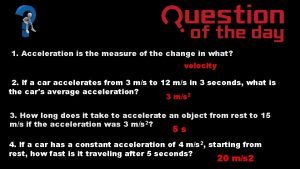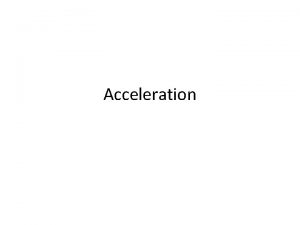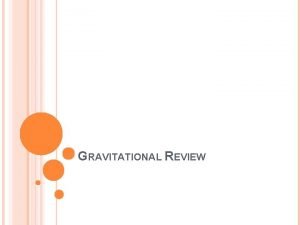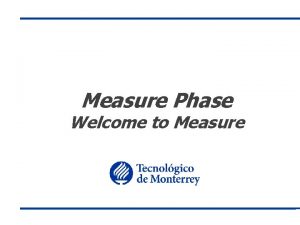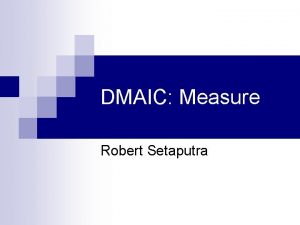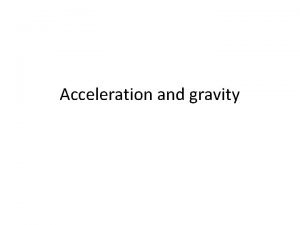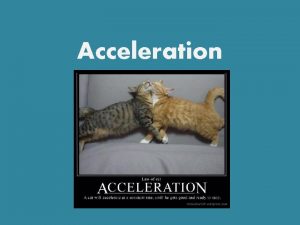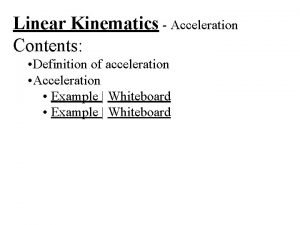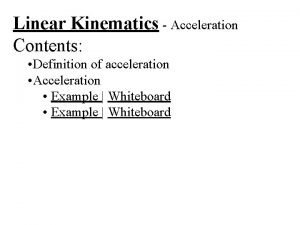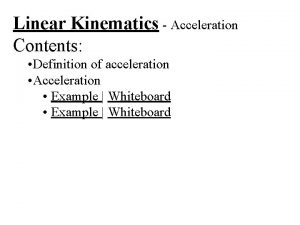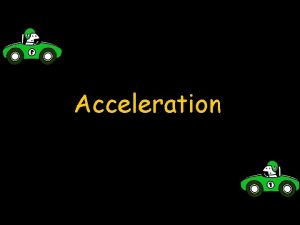Acceleration Acceleration Acceleration is the measure of how
















- Slides: 16

Acceleration

Acceleration • Acceleration is the measure of how fast something speeds up or slows down. • SI units for Acceleration =m/s 2

Acceleration • When velocity of an object changes • An object speeds up or slows down • An object turns (changes direction)

Equation for Acceleration * Vi can also be written as Vo (original velocity)

Acceleration • Acceleration is a vector because it has magnitude and direction. • If the final velocity is greater than the initial velocity then the ΔV (acceleration) will be positive. • If the final velocity is less than the initial velocity then the ΔV (acceleration) will be negative.

A positive acceleration means an increase in velocity; a negative acceleration usually means a decrease in velocity (deceleration). NB!! Negative acceleration is in OPPOSITE direction of the velocity

Example 1: A runner makes one lap around a 200 m track in a time of 25 s. What is the runner's average speed? G-Givens: d = 200 m t = 25 s U-Unknown: Sav Diagrams: Duncan Phillips AMCHS ‘ 07 ‘O 6 State Gold Medal 1600 m E-Base formula/rule: S-Answer: 8 m/s Sav = d t S-Work: Sav = d t m s = 8 m/s

Example 2: According to the World Disk Federation, on April 8, 2000 Jennifer Griffin threw a Frisbee for a distance of 138. 56 m to capture the woman’s record. If the Frisbee was thrown horizontally with a speed of 13. 0 m/s, how long did the Frisbee remain aloft? G-Givens: Sav = 13. 0 m/s d = 138. 56 m U-Unknown t = ? Diagrams: E-Base formula/rule: Sav = d t S-Work: t= d Sav S-Answer: = 10. 7 s = 138. 56 m = 10. 658 13. 0 m/s

Example 3: An object starts from rest with a constant acceleration of 8 m/s 2 along a straight line. Find the speed at the end of 5 s G: Vo = 0 m/s a = 8 m/s 2 t = 5 s U: Vf = ? Diagrams: E: Baseformula/rule: S-Answer: Vf = 40 m/s S: Work: Vf = 0 m/s + (8 m/s 2)(5 s) Vf = 40 m/s

Example 4: A truck's speed increases uniformly from 15 km/h to 60 km/h in 20 s. Determine the acceleration. G- Givens: vo = 15 km/h = 4. 17 m/s vf = 60 km/h = 16. 7 m/s t = 20 s E: Baseformula/ rule: S-Answer: = 0. 63 m/s 2 S- Work: Unknown = a m/s s Diagrams: = 0. 6265 m/s 2

Example 5: A bus moving at a speed of 20 m/s begins to slow at a constant rate of 3. 0 m/s 2. How long before it stops? Givens: Vo = 20 m/s Vf = 0 m/s t =? a = - 3 m/s/s Diagrams: Base formula/rule: Work: t = Vf – Vo a t = 0 – 20 m/s -3 m/s 2 t = 6. 6667 s Answer: t = 6. 67 s

Practice • • • Sakhile and Matthew walk eastward with a speed of 0. 98 m/s. If it takes them 34 min to walk to the store, how far have they walked? Given: Speed = 0. 98 m/s, time = 34 minutes (2040 sec) Unknown: How far? Distance = ? Equation: Speed = distance / time v = d/t rearrange for distance d = vt Substitute/Solve: d = (. 98 m/s) (2040 s) d = 1999. 2 meters

PROBLEM SOLVING GUIDELINES • Make a list of given quantities (Data) • Convert units if needed (e. g mins sec) • Make a drawing if necessary • Identify what is to be determined • Determine the equation needed • Always solve the equation for the unknown and be consistent with units • Check that the answer seems reasonable

QUESTION: A baseball player sprints from 1 st base, to 2 nd base. If her velocity is 9. 3 m/s when she is 8 m from 2 nd base and 7. 5 m/s when she is 5 m from 2 nd base 0. 4 s later. What is her acceleration over that 3 m interval?

ANSWER: Acceleration = (vf – vi) t = (7. 5 – 9. 3) m/s 0. 4 s = -1. 8 m/s 0. 4 s = -4. 5 m/s

Conversions: • • • Min Sec = x 60 Sec min = ÷ 60 Min hour = ÷ 60 Hour min = x 60 M km = ÷ 1000 Km m = x 1000 Mm cm = ÷ 10 Cm mm = x 10 Cm m = ÷ 100 M cm = x 100 If you are converting to a BIGGER unit the number will decrease/ get smaller If you are converting to a SMALLER unit the number will get bigger
 Gibbons jacobean city comedy download
Gibbons jacobean city comedy download Barometer
Barometer Acceleration is the measure of the change in
Acceleration is the measure of the change in Acceleration is a measure of
Acceleration is a measure of Units to measure acceleration
Units to measure acceleration Angular quantities
Angular quantities Radial acceleration definition
Radial acceleration definition Angular acceleration and linear acceleration
Angular acceleration and linear acceleration Circular acceleration
Circular acceleration Centripetal acceleration tangential acceleration
Centripetal acceleration tangential acceleration Các châu lục và đại dương trên thế giới
Các châu lục và đại dương trên thế giới Thế nào là hệ số cao nhất
Thế nào là hệ số cao nhất Sơ đồ cơ thể người
Sơ đồ cơ thể người Tư thế ngồi viết
Tư thế ngồi viết đặc điểm cơ thể của người tối cổ
đặc điểm cơ thể của người tối cổ Bàn tay mà dây bẩn
Bàn tay mà dây bẩn Hát kết hợp bộ gõ cơ thể
Hát kết hợp bộ gõ cơ thể


